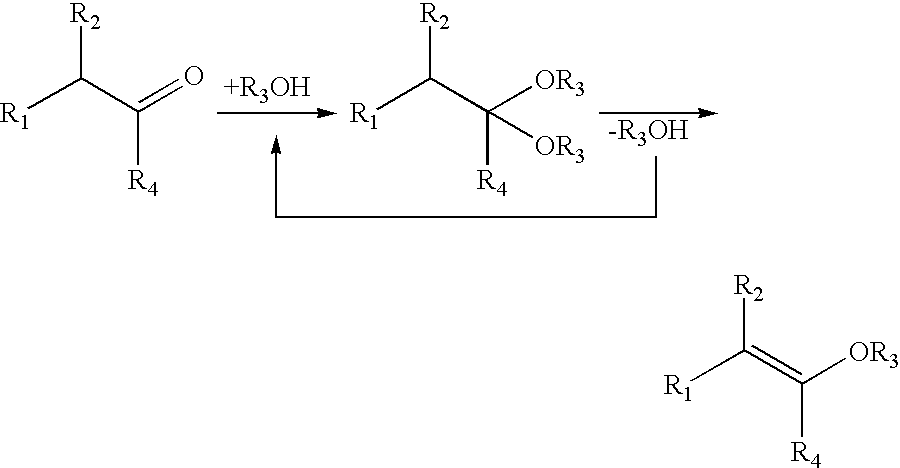Process for the production of isopropenyl methyl ether
a technology methyl ether, which is applied in the field of isopropenyl methyl ether production, can solve the problems of not being able to achieve a complete educt conversion under moderate conditions, low yield of isolated dmp, and inability to produce ipm in large yields
- Summary
- Abstract
- Description
- Claims
- Application Information
AI Technical Summary
Benefits of technology
Problems solved by technology
Method used
Image
Examples
example 1
[0097] Pyrolysis of the DMP-acetone solution (product stream IV) with 2-ethylhexanoic acid as catalyst:
[0098] The liquid catalyst acid 2-ethylhexanoic acid (2-EHS, 314.1 ml; 283.6 9) is placed in a double-walled glass vessel equipped with a mechanical stirrer and externally heated via a thermostatically controlled heater. The glass reactor is connected to a 5-tray bubble cap column (internal diameter: 50 mm), via which the vapour-phase reaction products are rectified. DMP-containing product stream IV consisting of the following components is metered in through a capillary:
2 IPM: / wt. % DMP: 94.0 wt. % (= 41.64 mole) Acetone: 5.0 wt. % (= 3.97 mole) Water: 1.0 wt. % (= 2.56 mole)
[0099] The catalyst acid is heated to a reaction temperature of 130 .degree. C., and an LHSV (Liquid Hourly Space Velocity) of 0.59 1 feed / h / 1.sub.2-EHS is adjusted at a constant reflux ratio of 1:1. A mixture of unreacted DMP, IPM, methanol and acetone is condensed at the head of the column and the quantita...
example 2
[0102] Reaction of methanol with acetone at low temperatures in the presence of an acidic ion exchanger (generation of product stream I), combination with product stream VI (pyrolysis stream from the DMP pyrolysis), extraction of the product stream II with aqueous sodium hydroxide solution and distillation I of the resulting IPM-DMP-acetone-containing product stream III.
[0103] A glass column (internal diameter: 27 mm, length: 100 cm) that can be cooled with a double-walled jacket is packed with an acidic and a basic ion exchanger that have previously been activated and purified according to described methods. 250 g of DOWEX 50 (acidic; density 0.73 g / ml;=280.4 ml) are used as acidic ion exchanger and 59.5 9 of DOWEX 1 (density: 0,58 g / ml=103 ml) are used as basic ion exchanger. The ion exchanger zone is cooled to -20.degree. C. with a cryostat and a solution of acetone and methanol in a molar ratio of 1:4 is cooled to room temperature and then pumped into the reactor. 0.44 kg of the...
example 3
[0108] Distillation I of the DMP-IPM solution (product stream III)
[0109] The DMP-IPM mixture is distilled in a distillation column consisting of a feed pump, circulatory evaporator with level regulation, a 2 m DN 80 column with DX packings, and a condensate splitter. The mixture is fed in at the middle of the column.
[0110] The mixture separates as follows:
5TABLE II Product Product Product Product Stream V: (IPM + Component Stream Stream Stream V: Aqueous Aqueous) (%) III IV IPM Phase Phase Phase MeOH 0.18 0 0.38 10.6 0.58 Acetone 7.89 11.27 0.46 0.49 0.46 IPM 32.8 2.5 98.7 0.65 96.8 DMP 58 85.1 0 0 0 Water 1.17 0.65 0.46 88.12 2.2 High b.p. 0.4 0.65 0 0.12 0 compds.
[0111] It can be seen from the quantitative data that the individual components behave in a chemically inert manner to one another during the distillation. It can also clearly be seen from the figures for the individual IPM-containing product streams III ,IV and V that the water content in the product stream IV intended f...
PUM
| Property | Measurement | Unit |
|---|---|---|
| boiling point | aaaaa | aaaaa |
| temperatures | aaaaa | aaaaa |
| temperatures | aaaaa | aaaaa |
Abstract
Description
Claims
Application Information
 Login to View More
Login to View More - R&D
- Intellectual Property
- Life Sciences
- Materials
- Tech Scout
- Unparalleled Data Quality
- Higher Quality Content
- 60% Fewer Hallucinations
Browse by: Latest US Patents, China's latest patents, Technical Efficacy Thesaurus, Application Domain, Technology Topic, Popular Technical Reports.
© 2025 PatSnap. All rights reserved.Legal|Privacy policy|Modern Slavery Act Transparency Statement|Sitemap|About US| Contact US: help@patsnap.com



